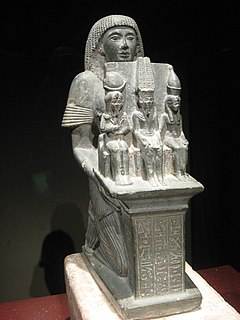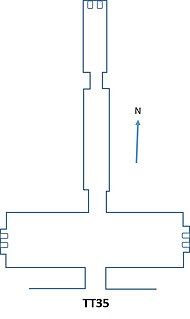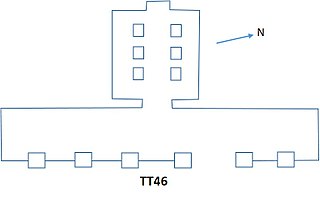Related Research Articles

Ahmose I was a pharaoh and founder of the Eighteenth Dynasty of Egypt, classified as the first dynasty of the New Kingdom of Egypt, the era in which ancient Egypt achieved the peak of its power. He was a member of the Theban royal house, the son of pharaoh Seqenenre Tao and brother of the last pharaoh of the Seventeenth dynasty, Kamose. During the reign of his father or grandfather, Thebes rebelled against the Hyksos, the rulers of Lower Egypt. When he was seven years old, his father was killed, and he was about ten when his brother died of unknown causes after reigning only three years. Ahmose I assumed the throne after the death of his brother, and upon coronation became known as nb-pḥtj-rꜥ "The Lord of Strength is Ra".

Akhenaten, also spelled Echnaton, Akhenaton,, was an ancient Egyptian pharaoh reigning c. 1353–1336 or 1351–1334 BC, the tenth ruler of the Eighteenth Dynasty. Before the fifth year of his reign, he was known as Amenhotep IV.

Amenhotep III, also known as Amenhotep the Magnificent or Amenhotep the Great, was the ninth pharaoh of the Eighteenth Dynasty. According to different authors, he ruled Egypt from June 1386 to 1349 BC, or from June 1388 BC to December 1351 BC/1350 BC, after his father Thutmose IV died. Amenhotep was Thutmose's son by a minor wife, Mutemwiya.

Amenhotep I, Amenôthes I, or Amenophis I, (,) from Ancient Greek Ἀμένωφις, additionally King Djeserkare, was the second Pharaoh of the 18th Dynasty of Egypt. His reign is generally dated from 1526 to 1506 BC. He was a son of Ahmose I and Ahmose-Nefertari, but had at least two elder brothers, Ahmose-ankh and Ahmose Sapair, and was not expected to inherit the throne. However, sometime in the eight years between Ahmose I's 17th regnal year and his death, his heir apparent died and Amenhotep became crown prince. He then acceded to the throne and ruled for about 21 years. Although his reign is poorly documented, it is possible to piece together a basic history from available evidence. He inherited the kingdom formed by his father's military conquests and maintained dominance over Nubia and the Nile Delta but probably did not attempt to maintain Egyptian power in the Levant. He continued the rebuilding of temples in Upper Egypt and revolutionized mortuary complex design by separating his tomb from his mortuary temple, setting a trend in royal funerary monuments which would persist throughout the New Kingdom. After his death, he was deified as a patron god of Deir el-Medina.

The necropolis of Draʻ Abu el-Naga' is located on the West Bank of the Nile at Thebes, Egypt, just by the entrance of the dry bay that leads up to Deir el-Bahari and north of the necropolis of el-Assasif. The necropolis is located near the Valley of the Kings.

Anen or Aanen was an ancient Egyptian official during the late 18th Dynasty of Egypt.

Ramessesnakht was High Priest of Amun during many years in the 20th Dynasty. He was appointed as the High Priest at Thebes under Ramesses IV. He served in office until the reign of Ramesses IX. It was during Ramessesnakht's tenure that the power and importance of the Amun priesthood grew over Egypt while the Pharaoh's power began to noticeably decline.

The High Priest of Amun or First Prophet of Amun was the highest-ranking priest in the priesthood of the ancient Egyptian god Amun. The first high priests of Amun appear in the New Kingdom of Egypt, at the beginning of the Eighteenth Dynasty.
Sennefer or Senneferi was an ancient Egyptian official during the 18th Dynasty.

The Theban Tomb TT16 is located in Dra' Abu el-Naga', part of the Theban Necropolis, on the west bank of the Nile, opposite to Luxor. It is the burial place of the ancient Egyptian Panehsy, who was Prophet of Amenhotep (I) of the Forecourt, during the reign of Ramesses II.

The Theban Tomb TT14 is located in Dra' Abu el-Naga'. It forms part of the Theban Necropolis, situated on the west bank of the Nile opposite Luxor. The tomb is the burial place of the ancient Egyptian Huy, who was a wab-priest of Amenhotep, the favorite of Amun.
Meryptah was a High Priest of Amun during the time of Amenhotep III.
Nebwenenef was High Priest of Amun at the beginning of the reign of Ramesses II during the 19th Dynasty. Prior to that, Nebwenenef had served as High Priest of Anhur and High Priest of Hathor during the reign of Seti I and possibly even earlier.

The Theban Tomb TT19 is located in Dra' Abu el-Naga', part of the Theban Necropolis, on the west bank of the Nile, opposite to Luxor. It is the burial place of the ancient Egyptian Amenmose, who was the high priest of Amenhotep of the Forecourt during the early Nineteenth Dynasty.

The Theban Tomb TT35 is located in Dra Abu el-Naga, part of the Theban Necropolis, on the west bank of the Nile, opposite to Luxor. It is the burial place of the ancient Egyptian noble named Bakenkhons I, who lived during the 19th Dynasty, during the reign of Ramesses II. Bakenkhons was a High Priest of Amun.

The Theban Tomb TT46 is located in Sheikh Abd el-Qurna. It forms part of the Theban Necropolis, situated on the west bank of the Nile opposite Luxor.
The Theban Tomb TT48 is located in El-Khokha, part of the Theban Necropolis, on the west bank of the Nile, opposite to Luxor. TT48 was the burial place of the ancient Egyptian named Amenemhat called Surer, who was a Chief Steward, At the head of the King, Overseer of the Cattle of Amun. Amenemhat called Surer dates to the time of Amenhotep III from the middle of the Eighteenth Dynasty of Egypt. He was a son of Ith-taui, who was an overseer of the cattle of Amun and the lady Mut-tuy.
The Theban Tomb TT169 is located in Dra' Abu el-Naga', part of the Theban Necropolis, on the west bank of the Nile, opposite to Luxor. It is the burial place of the ancient Egyptian Senna, who was the head of the goldworkers of Amun during the reign of Amenhotep II in the Eighteenth Dynasty.
This page list topics related to ancient Egypt.

The Theban Tomb TT68 is located in Sheikh Abd el-Qurna, part of the Theban Necropolis, on the west bank of the Nile, opposite to Luxor. The tomb was initially started for the High Priest of Amun Meryptah, during the 18th Dynasty. The tomb was later built over by Paenkhemenu during the 20th Dynasty. During the 21st Dynasty the tomb was again usurped by Nespaneferhor and his son Hor.
References
- 1 2 Aidan Dodson, Amarna Sunrise: Egypt from the Golden Age to the Age of Heresy, The American University in Cairo Press, pp. 102, 2014
- 1 2 3 Donald B. Redford: "The Identity of the High-Priest of Amun at the Beginning of Akhenaten's Reign", Journal of the American Oriental Society, Vol. 83, No. 2 (Apr., 1963), pp. 240-241
- ↑ Thomas Hikade, "Expeditions to the Wadi Hammamat during the New Kingdom", The Journal of Egyptian Archaeology, Vol. 92 (2006), pp. 153-168
- ↑ Cyril Aldred, "Two Theban Notables during the Later Reign of Amenhotep III", Journal of Near Eastern Studies, 1959
- ↑ Porter, Bertha and Moss, Rosalind, Topographical Bibliography of Ancient Egyptian Hieroglyphic Texts, Statues, Reliefs and Paintings Volume I: The Theban Necropolis, Part 2. Royal Tombs and Smaller Cemeteries, Griffith Institute. 1964, pp 611
- ↑ Polz D. et.al.: Bericht Uber die 9. bis 12. Grabungskampagne in der Nekropole von Dra'Abu el-Naga/Theben West, in MDAIK 59 (2003), pp. 373-74